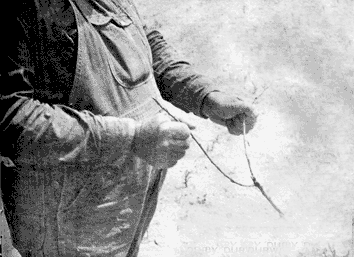WATER WELLS AND WITCHING FOR WATER – Big Hill Country
The early settlers arriving in Big Hill Country found it very important to find a good source of water near which to build. The water supply and its source played a very important part in the settlers’ choice of land because the amount of water available determined the number of stock they could own. They tried to settle close to a spring or creek, if possible. As more homesteaders moved into the area, other sources of water had to be found, so wells were dug. This was hard work and generally required two persons; one was down the hole digging and filling a bucket, which was then hauled to the surface by his partner, using a rope or a windlass. Often the settler’s wife was the person hauling up the dirt. In many areas the wells were over a hundred feet deep and required cribbing as they were dug, to prevent cave-ins. Once the water was found, the well had to be cribbed regardless of depth. Flat rocks, rails or planks were used. The wells had to be covered to prevent accidents, and a pump installed if the settler could afford one. Otherwise, a rope and windlass system was used.
The art of witching or dowsing for water is a very interesting subject. There are many people who do not believe in it, hence the probable origin of the name “witching”, but if those same people have to have a well drilled, the first thing they do is to start looking for a well-witcher. One witcher in the Cochrane district witched over twenty wells in the area in 1976.
Some water witchers use a forked willow branch and by gripping the two forks firmly, the willow rod will move up and down when placed over and underground current of water. Some people use two metal rods called divining rods or even wire. Sometimes when the willow rods are held tight, and the pull from the underground stream is strong, the witcher’s hands will strip the bark off the willow. The witcher generally tries to find the intersection of two streams of water as a suitable place to drill for water. He can tell how deep the stream is, and how many gallons of water per minute a well can be expected to produce.
Witching does not work for everyone, but when the wrists of an unsuccessful person are held by a witcher, the rod will turn to indicate an underground stream.
An encyclopedia states, “Persons using this device are sometimes successful only because they have a common-sense idea of where water is usually found.” This statement has not always been true; the ability to witch for water seems to be inherited.
Some people call witching magic; others, voodoo; it is even suggested that it is a form of extra-sensory perception. In any case, many of the wells dug or drilled in the Cochrane area through the years have had their location chosen by a water witcher.



My Mom Bilinda (Billy) Beynon witched all the wells on the farm. She would use a green willow in the shape of Y. She could tell you how strong the water flow was and about how deep down it was. She could use a crowbar also but it wasn’t as accurate.